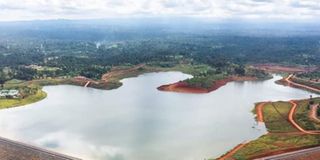Joy for Mwea rice farmers as Thiba Dam full to capacity

The Sh20 billion Mwea Thiba dam which is meant to boost rice production in this photo taken in July 2022.
The multibillion-shilling Thiba Dam in Kirinyaga County is now full with 15.6 million cubic metres of water and the surplus overflowing through the spillway.
The dam started collecting water in May after completion in March.
The building of the reservoir started in 2018 and took four years.
The Sh8.2 billion dam is a one of the flagship projects the government is banking on to make Kenya a food-secure country through massive production of rice.
The dam has revived the hopes of thousands of rice farmers in the Mwea Irrigation Scheme (NIA) who faced chronic water shortages in dry seasons.
The filling of the dam marks the successful completion of the project and allows farmers in Mwea to plant crops without fear of water shortages, said National Irrigation Authority spokesperson Daniel M. Nzonzo.
Mr Nzonzo added that the dam was built within the time allotted and cost less than expected.
“The authority spent Sh7.8 billion against the target sum of Sh8.2 billion. I attribute this to enhanced management and supervision during the implementation of the project by NIA officers," Mr Nzonzo said.
The Mwea Irrigation Scheme covers 25,000 acres and is one of seven such schemes in Kenya under the management of the NIA. But it has been operating below capacity due to water shortages caused by the adverse effects of climate change.
The 40-metre tall and one-kilometre-long dam will help secure year-round water supply, with rice farmers set to be the biggest beneficiaries.
NIA chief executive Gitonga Mugambi previously said the beneficiaries are not only farmers “but everybody who consumes rice in the country as the projects will double rice production”.
Rice is Kenya's third staple food after maize and wheat. The country produces only 35 percent of rice consumed locally and supplements low supply with imports.
The dam is expected to provide irrigation water to another 10,000 acres, up from the current 25,000-acre Mwea Irrigation Settlement Scheme in efforts to boost rice farming in the area.
Statistics show that Kenya consumes 450,000 metric tonnes of rice per year, against production of 160,000, with the Mwea scheme contributing about 114,000. To bridge the gap, Kenya imports rice from Asian countries such Vietnam and Pakistan.
Once the dam is put to use, rice production is projected to rise to over 250,000 metric tonnes a year.
The Japanese government, through the Japan International Cooperation Agency, and the Kenyan government funded the project.
The project will grow the economy of the area by double digits, said Mwea Water Users Association chairperson Maurice Mutugi.
'This will see the area grow in leaps and bounds as we will be planting two crops per year and this will help even generations to come," said Mr Mutugi
He said farmers are happy and expect bumper harvests, but there are some concerns.
“What is worrying us the most is whether there is a market [for the rice],” he said.





